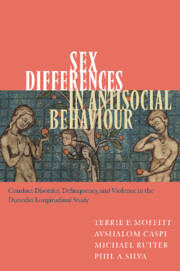 Sex Differences in Antisocial Behaviour
Sex Differences in Antisocial Behaviour Book contents
- Frontmatter
- Contents
- List of figures
- List of tables
- Preface
- Acknowledgements
- 1 Introduction
- 2 The Dunedin Multidisciplinary Health and Development Study
- 3 Sex differences in the amount of antisocial behaviour: dimensional measures
- 4 Sex differences in the prevalence of antisocial behaviour: categorical diagnostic measures
- 5 Sex differences in physical violence and sex similarities in partner abuse
- 6 Sex and the developmental stability of antisocial behaviour
- 7 Sex and the age of onset of delinquency and conduct disorder
- 8 Sex effects in risk predictors for antisocial behaviour: are males more vulnerable than females to risk factors for antisocial behaviour?
- 9 Sex effects in risk predictors for antisocial behaviour: are males exposed to more risk factors for antisocial behaviour?
- 10 Can sex differences in personality traits help to explain sex differences in antisocial behaviour?
- 11 Sex and comorbidity: are there sex differences in the co-occurrence of conduct disorder and other disorders?
- 12 Do girls who develop antisocial behaviour surmount a higher threshold of risk than their male counterparts?
- 13 Sex differences in the effects of antisocial behaviour on young adult outcomes
- 14 Sex, antisocial behaviour, and mating: mate selection and early childbearing
- 15 Evaluating the recommendation to relax the criteria for diagnosing conduct disorder in girls
- 16 Life-course persistent and adolescence-limited antisocial behaviour among males and females
- 17 Priorities for a research agenda
- References
- Index
15 - Evaluating the recommendation to relax the criteria for diagnosing conduct disorder in girls
Published online by Cambridge University Press: 22 September 2009
- Frontmatter
- Contents
- List of figures
- List of tables
- Preface
- Acknowledgements
- 1 Introduction
- 2 The Dunedin Multidisciplinary Health and Development Study
- 3 Sex differences in the amount of antisocial behaviour: dimensional measures
- 4 Sex differences in the prevalence of antisocial behaviour: categorical diagnostic measures
- 5 Sex differences in physical violence and sex similarities in partner abuse
- 6 Sex and the developmental stability of antisocial behaviour
- 7 Sex and the age of onset of delinquency and conduct disorder
- 8 Sex effects in risk predictors for antisocial behaviour: are males more vulnerable than females to risk factors for antisocial behaviour?
- 9 Sex effects in risk predictors for antisocial behaviour: are males exposed to more risk factors for antisocial behaviour?
- 10 Can sex differences in personality traits help to explain sex differences in antisocial behaviour?
- 11 Sex and comorbidity: are there sex differences in the co-occurrence of conduct disorder and other disorders?
- 12 Do girls who develop antisocial behaviour surmount a higher threshold of risk than their male counterparts?
- 13 Sex differences in the effects of antisocial behaviour on young adult outcomes
- 14 Sex, antisocial behaviour, and mating: mate selection and early childbearing
- 15 Evaluating the recommendation to relax the criteria for diagnosing conduct disorder in girls
- 16 Life-course persistent and adolescence-limited antisocial behaviour among males and females
- 17 Priorities for a research agenda
- References
- Index
Summary
In this chapter we address a debate in the field about the best way to diagnose conduct disorder among females. Should the sexes be diagnosed using the same criteria, as is now done? Or should the diagnostic criteria for females be relaxed to a milder standard than the criteria for males?
Leading one side of this debate, Zoccolillo (1993) has argued for genderspecific criteria, recommending that fewer symptoms should be required for diagnosing girls than boys. This argument is based on the clinical observation that girls with levels of symptoms that would be considered mild for a boy (and below DSM's diagnostic threshold) nevertheless often experience clinically significant problems in their health and social functioning. In one study that evaluated the recommendation to relax the diagnostic criterion, doing so predictably raised the prevalence rate of conduct disorder for a sample of 10-year-old girls, but also netted more of the sample's girls who had a history of early-onset pervasive behaviour problems in kindergarten (Zoccolillo, Tremblay, and Vitaro, 1996). This result suggested that relaxing the diagnostic criteria for girls may augment sensitivity of the conduct-disorder diagnosis to consequential female cases. However, no boys were studied, so we do not know whether relaxed criteria might have benefited measurement validity for both sexes at age 10.
On the other side of this debate, Zahn-Waxler (1993) has argued that we should reject the recommendation for relaxing conduct-disorder diagnostic criteria for girls.
- Type
- Chapter
- Information
- Sex Differences in Antisocial BehaviourConduct Disorder, Delinquency, and Violence in the Dunedin Longitudinal Study, pp. 198 - 206Publisher: Cambridge University PressPrint publication year: 2001


